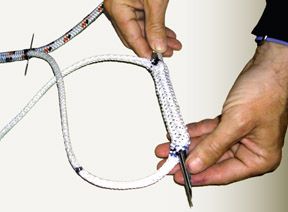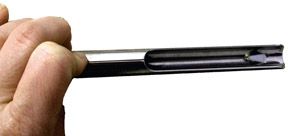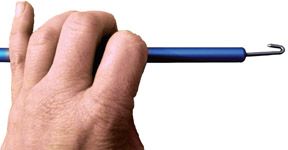
While pre-spliced lines are easy to come by these days through marine chandleries, riggers, or the major rope suppliers, the sailors art of splicing is far from obsolete. The near extinction of wire halyards means halyards on cruising boats will need to be respliced more frequently to prevent chafe. And for boats that roam widely, a skilled rigger isn’t always at hand when its time to swap the halyard end-for-end, or change the nip at the sheave. The skill is becoming even more essential today, as double-braid lines with high-tech fiber cores become more common on board.
With low-stretch fibers (Spectra, Vectran, etc.), splices should always be used in preference to knots to maintain line strength. A knot can reduce strength in line with high-tech fibers by as much as 75 percent, while a proper splice will reduce strength by less than 20 percent.
The three types of line commonly used and spliced on sailboats each require a specific splicing technique. Three-strand splices (anchor and dock lines) are quite easy to do with minimal instructions. While this splice can be done without any fid at all, a tool can be useful for opening up space between the strands. A standard hollow fid makes this job easier.
Hollow, single-braid line is the easiest to splice and requires only a piece of thin rod about 18 inches long. Hollow, single-braid construction gets used in polypropylene line, as in waterski tow ropes, or in the Spectra lines meant for use as spinnaker halyards/sheets and mainsail control lines (reefing lines, etc).
Double-braid line, with Dacron or nylon fibers, is the most common aboard sailboats. It gets used for almost all applications, including sheets and halyards.
There are two different splices used depending on whether the core of the line is made from the same material as the cover (typically nylon) or made from a high-modulus, low-stretch fiber like Spectra or Vectran (see The Fine Art of Splicing). Unfortunately, these double-braid splices are by far the most complicated and least intuitive. They also require special fids, and with the exception of the hollow fid for three-strand line, these make up the range of fids PS gathered for this test. With practice, double-braid splices are not difficult, and an experienced rigger likely can do one in about two minutes. The average sailor who might make one such splice in a season can expect to waste some line in a couple of practice splices before getting it right, but he can expect to make up for his time and expenses in a couple of seasons.
Buying and learning to use your own fids really pays off if you are completely re-rigging and have a dozen splices to do, or if you plan to sail to remote areas without riggers. A couple of afternoons spent with a fid and a piece of new 3/8-inch double-braid line (much easier to splice than stiff, old line) will allow you to produce a useful if not picture-perfect splice.
How We Tested
For this test, we collected a variety of readily available fids from Selma, New England Ropes (Uni-Fid II), Samson ropes, and the late, great rigger Brian Toss (Toss Wand and Point Hudson). PS tester has used versions of each of these fids for about a decade. The primary way these fids differ is in how you attach a strand of line to them. When making a splice, this connection has to be forcefully pushed or pulled through very tight channels in the line, so the union needs to be strong, compact, and quick to make and undo, because youll have to connect and disconnect the fid several times in the course of making one splice.
For the recreational splicer, excellent instructions are perhaps the most important factor in learning how to make good splices. Each double-braid fid system makes the same splices, but the instructions differ a great deal, so much that you might not even know they were designed to make the same splice.
To test the fids, PS sat down with each set of instructions and tried to make several splices following them exactly.
If you can’t make heads or tails of the instructions included with your fids, you can always get additional instructions. There are numerous books with splicing instructions, however, many have not been updated with the latest techniques for low-stretch line. Our tester liked Brion Toss’ The Complete Riggers Apprentice and Barbara Merry’s The Splicing Handbook. And excellent splicing instructions can be found at the New England Ropes website: http://www.neropes.com/.
These fids will likely spend most of their time sitting in a drawer and get pulled out only once or twice a year, so they need to be in a compact, easy-to-stow package, and be made of durable, corrosion-resistant materials.
Selma Fids
These fids are one of two types in our test that can easily be used for both double-braid and three-strand splices (the other is the Toss Wand). They are nicely made of 100 percent stainless steel. The set contains five fids that will splice line ranging from 1/8 inch to 9/16 inch, and our tester has used the large size to splice up to -inch line. They are neatly designed so that they nest inside each other, and the stowed package is only the size of the largest fid.
Of the three fid types designed to be pushed rather than pulled through the splices (the others are the Uni-fid and Samson), the Selma fids have the best-designed approach for attaching the line to the fid. The line is laid into a hollow in the center of the fid where it engages a hook. One layer of tape around the hook holds fid and line in tight contact. The whole package is very firmly attached and streamlined.

The fids come with pretty good instructions to do three-strand and the most common double-braid (Dacron/Dacron, or nylon/nylon) splices. These instructions are good enough to help someone who has done a couple of double-braid splices before, but are a bit too brief as initial instructions for a novice. No instructions are included for low-stretch, double-braid line with high-modulus (Spectra or Vectran) fiber cores and nylon covers, though the fids can be used for this type of line.
At $50, this is the second most expensive set of fids. The Toss Wand is the most expensive.
Bottom Line: If you could have only one fid set on board, this would be the one. It can be used for both three-strand and double-braid line. Its durably constructed and stows compactly, and its line attachment design is the best of the pusher style. PS would add a splicing book with more detailed instructions and additional splice types, especially the low-stretch, double-braid, core-to-core splice.
Uni-Fid II
This two-fid set from New England Ropes can do double braid splices in -inch to 1-inch line. The fid body is made of anodized aluminum with a stainless hook set on the end. In the past, these hooks were made of mild steel, which rusted, and they bent and pulled out entirely from the aluminum body. However, New England Ropes has obviously tried to resolve these problems with the current product; the hooks are now stainless steel and of a larger gauge. Only time will tell if they are now strong enough.
The two fids come in a strong plastic tube the same length as the Selmas, but with 50 percent greater diameter.
To attach the line to the fid, you put a wrap of tape around the end of the line, slip the hook into the line inside of the tape and then put another wrap around the line and fid to create a smooth package. This usually works, but the tape and fid sometimes pull right off the line in really tight situations. Tapered line will have little nubs sticking out where it has been thinned, and these can create friction.
This package comes with by far the best standard instructions. In addition to very detailed double-braid instructions, it shows how to splice single braid, parallel core double-braid and low-stretch double-braid, and end-to-end splices. New England Ropes has done sailors a great service by making these instructions free online at the New England Ropes website, http://www.neropes.com/.
At $30, this is the least expensive of the double-braid splicing sets.Bottom Line: With excellent instructions, a low price, and acceptable functionality, this would be the set to get to learn to splice and use for one or two splices a year.
Samson Fids
This is a five-fid set that can do double-braid splices in -inch to -inch line. The fid body is made of raw aluminum. It comes with a spike type tool to help push the fid through especially long splices.
The fids come in a vinyl pouch (prone to cracking as it ages) slightly shorter than the above two fid sets, but about twice as wide.
To attach the line to the fid, stick the end of the line into a hollow in the end of the fid and wrap it with tape. Our testers found this method to be much less secure than the fids with hooks.
This package comes with basic instructions for the simple double-braid splice and the low-stretch double-braid splice.
At $36, this is a mid-priced double-braid splicing set.
Bottom Line: In our opinion, this set is overpriced and will frustrate many splicers with its tenuous line attachment design.
Toss Wand
Developed by Brian Toss, this is one fid that can splice double braid line from 3/8-inch to 3/4-inch (there is another Toss Wand for smaller line). The fid can also be used for three-strand splices, but the stainless tube is of light gauge, and you would not want to use it to lever open the strands on old, stiff line. The fid is nicely made and consists of a stainless tube with a plastic handle and a Spectra snare that is used to attach the line to the fid.
This fid has a unique design. Instead of attaching the line to the fid and pushing both through the splice, you pass the fid through the splice, lasso the line with the Spectra snare, and then pull it back out of the splice. There was a wire snare in a previous version of this fid, but that caused various problems. The Spectra snare is a big improvement. It creates a secure attachment, but it can be a little tricky to keep it smooth and streamlined. Our testers found the attachment to be a bit lumpy, with a tendency to distort tapered line. They suspected that over time, theyd learn just how much line to snare and when/if to use tape to make it smooth. The Spectra snare also will need to be replaced at some point (Toss sells replacements, $2 each, or three for $5).
The fid is 21 inches long, almost twice as long as the other fids, so it might not fit into a small toolbox.
The fid comes with very good instructions for a simple, double-braid splice. It includes many excellent tips to avoid or overcome the various tricky spots in a splice. It does not include instructions for other splices, but for $23, you can buy a book by Toss (Working Rope: Field Guides for Rigging, Book 5 – Basic Braided Splices) that covers various double-braid splices. It is an excellent book.
This is the most expensive fid at $55, and you will also need the Toss book or another splicing book for instructions on additional splices.
Bottom Line: If you were really going to get into splicing, this would be a good second fid (after the Selma fids). The pulling approach does simplify some parts of the splice, and its length makes it useful for doing hollow single-braid splices. It is a bit expensive for the occasional user and its length does make it a bit difficult to stow.
Point Hudson Fid
This fid is designed for three-strand line only, and there are many similar versions that work the same way. Essentially a shaped and polished stainless tube with a plastic handle, its a compact, easily stowed tool.

This design is common among the hollow fids for three-strand line, which evolved from the cone-shaped solid fids used on square riggers. The sharp end of the fid is used to open a gap between the strands; the fid is pushed through the gap; one strand of the line is fed into the fids hollow tube; and the fid and strand are pulled back through the splice.
You don’t need to use a fid for three-strand splices. The spike on a rigging knife can open a gap in the line and then you can push the strand end through the gap with the spike. However, if you were going to be doing a lot of three-strand splices, especially with old, stiff line, using this fid would make them easier and quicker.
The fid does not come with instructions, but almost any book on line, knots, or splices will have instructions for this relatively simple splice.
At $7, this fid is relatively inexpensive. You would need two more sizes (three in all) to cover the range of common line sizes. However, if you are only using three-strand for anchor and dock lines, one size will probably be enough.
Bottom Line: If you are going to be doing a large number of three-strand splices, especially in old, stiff line, this fid will make the job easier. Otherwise you can probably make any necessary three-strand splices with a rigging knife.
Conclusions
Each of these sets of fids present certain challenges that, after several splices, wont pose much too much of a problem. Nevertheless, it be came clear that some were better than others in terms of construction, value for your dollar and ease of use.
The Selma fid set is a clear choice for those wanting a single, do-anything fid set. Its fids are well designed; they work extremely well, are very durable, and stow compactly.
The Toss Wand is a good addition for the dedicated or specialty splicer. Its long tube design compliments the Selma approach.
The Uni-Fids II set from New England Ropes are the Best Buy for the beginner or very occasional splicer, with a low price and excellent instructions.
Contacts
Brion toss, 360/385-1080, http://www.briontoss.com/
New England Ropes, 800/333-6679, http://www.neropes.com/
Samson, 800/227-7673, http://www.samsonrope.com/
Selma, 47 33/31 40 4084, http://www.selma.no/



































